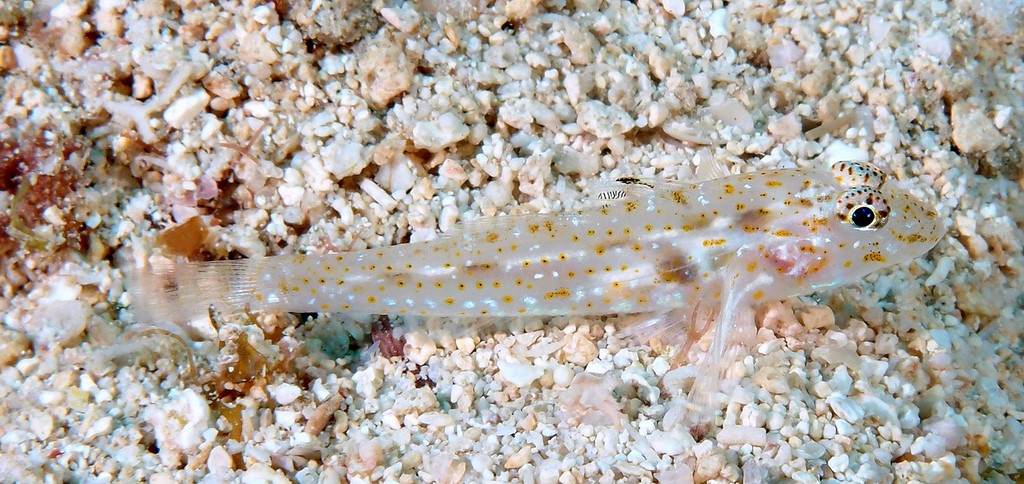FUSIGOBIUS DUOSPILUS - (HOESE & READER, 1985)
Actinopterygii (Gigaclass) > Actinopteri (Class) > Teleostei (Subclass) > Gobiiformes (Order) > Gobioidei (Suborder) > Gobiidae (Family) > Gobiinae (Subfamily) > Fusigobius (Genus)
Twospot sandgoby, Twospot goby, Twinspot sandgoby, Barenape goby, Sehoshi sankaku haze, セホシサンカクハゼ, 澳洲鯕塘鱧,
Description
Dorsal spines (total): 7; Dorsal soft rays (total): 9; Anal spines: 1; Anal soft rays: 8; Pectoral fin rays: 17-20; Gill rakers on outer face of first gill arch usually: 1 + 1 + 4-5; Lower rakers on outer face of second arch usually: 6-7; Longitudinal scale series: 22-25; Body depth: 4.3-5.8 in SL. Gill opening extending to or almost to vertical at posterior edge of opercle. Body with ctenoid body scales except large cycloid scales covering pectoral-fin base and prepelvic area; Midline of nape without scales; Scales extend no further forward than just above operculum; Operculum naked. First dorsal fin elevated anteriorly, without any filamentous spines, first 3 spines approximately equal in length; First dorsal fin just reaches to second dorsal origin or to first semented dorsal ray, when depressed; Pelvic fins nearly fully united to form a disc, thin membrane (easily torn) uniting them to or near to tips of fifth rays; Ventral frenum connecting pelvic spines rudimentary; Pelvic rays moderately branched, fifth ray usually with 4-6 branches, fourth ray with 4-6 branches in adults, 3-5 in juveniles; Caudal fin rounded. Max. length: 5.7 cm TL. Depth range: 1 - 46 m.
Color
Two large black spots on first dorsal fin, anterior spot often vertically elongate at tip of a thin black vertical line extending from base of fin, second spot between fifth and sixth dorsal spines; A faint black spot above anterior margin of pectoral base; Caudal peduncle with round to triangular spot; A thin vertical brown bar or oval blotch below eye.
Etymology
Fusigobius: from Latin, fusus = spindle + from Latin, gobius = gudgeon.
duospilus: from Latin, duo = two + from ancient Greek, spilos = spot. Referring to two dark spots on dorsal fin.
Original description: Fusigobius duospilus Hoese & Reader, 1985 - Type locality: Escape Reef, Great Barrier Reef, Queensland, Australia, depth 19-22 meters.
Distribution
Indo-West Pacific: East Africa, South Africa, Seychelles, Comoros, Madagascar and Mauritius (Mascarenes) east to Hawaiian Islands and Marquesas Islands, north to southern Japan and Ogasawara Islands, south to Australia, Lord Howe Island, New Caledonia and Tonga.
Biology
Inhabits sandy floors of holes and depressions of clear seaward reefs. Also found in sand-rubble bottoms next to reefs. Occurs singly or in groups, secretive. Benthic. Feeds on small invertebrates.
Twospot sandgoby, Twospot goby, Twinspot sandgoby, Barenape goby, Sehoshi sankaku haze, セホシサンカクハゼ, 澳洲鯕塘鱧,
Description
Dorsal spines (total): 7; Dorsal soft rays (total): 9; Anal spines: 1; Anal soft rays: 8; Pectoral fin rays: 17-20; Gill rakers on outer face of first gill arch usually: 1 + 1 + 4-5; Lower rakers on outer face of second arch usually: 6-7; Longitudinal scale series: 22-25; Body depth: 4.3-5.8 in SL. Gill opening extending to or almost to vertical at posterior edge of opercle. Body with ctenoid body scales except large cycloid scales covering pectoral-fin base and prepelvic area; Midline of nape without scales; Scales extend no further forward than just above operculum; Operculum naked. First dorsal fin elevated anteriorly, without any filamentous spines, first 3 spines approximately equal in length; First dorsal fin just reaches to second dorsal origin or to first semented dorsal ray, when depressed; Pelvic fins nearly fully united to form a disc, thin membrane (easily torn) uniting them to or near to tips of fifth rays; Ventral frenum connecting pelvic spines rudimentary; Pelvic rays moderately branched, fifth ray usually with 4-6 branches, fourth ray with 4-6 branches in adults, 3-5 in juveniles; Caudal fin rounded. Max. length: 5.7 cm TL. Depth range: 1 - 46 m.
Color
Two large black spots on first dorsal fin, anterior spot often vertically elongate at tip of a thin black vertical line extending from base of fin, second spot between fifth and sixth dorsal spines; A faint black spot above anterior margin of pectoral base; Caudal peduncle with round to triangular spot; A thin vertical brown bar or oval blotch below eye.
Etymology
Fusigobius: from Latin, fusus = spindle + from Latin, gobius = gudgeon.
duospilus: from Latin, duo = two + from ancient Greek, spilos = spot. Referring to two dark spots on dorsal fin.
Original description: Fusigobius duospilus Hoese & Reader, 1985 - Type locality: Escape Reef, Great Barrier Reef, Queensland, Australia, depth 19-22 meters.
Distribution
Indo-West Pacific: East Africa, South Africa, Seychelles, Comoros, Madagascar and Mauritius (Mascarenes) east to Hawaiian Islands and Marquesas Islands, north to southern Japan and Ogasawara Islands, south to Australia, Lord Howe Island, New Caledonia and Tonga.
Biology
Inhabits sandy floors of holes and depressions of clear seaward reefs. Also found in sand-rubble bottoms next to reefs. Occurs singly or in groups, secretive. Benthic. Feeds on small invertebrates.
